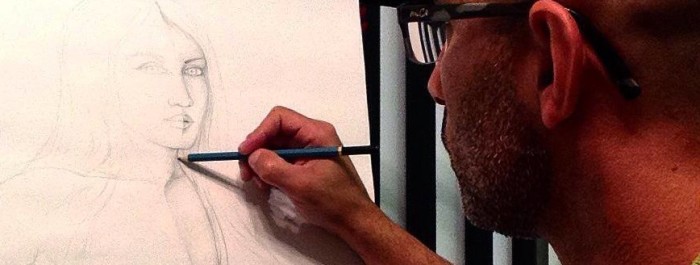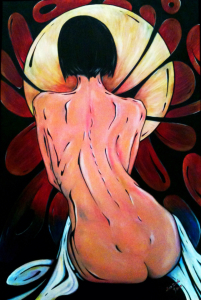Intersubjective Artistic Matrix

For a while now I’ve been thinking about writing on a subject that for many artists may result in defensive argumentation, as I’ve seen in the past during some conversations and online discussions. However, it is a subject that deserves attention not to establish a definite interpretation of benefits or causes for rejection, but to understand the teaching and therapeutic benefits of engaging in this practice. In past posts, I explored the subject (read: How to Explain Your Art). During the summer I began reading the book Art Therapy and the Neuroscience of Relationships, Creativity, and Resiliency: Skills and Practices by Noah Hass-Cohen and Joanna Clyde Findlay, and they introduced to me the term “Intersubjective Artistic Matrix” (IAM). IAM defines the artist’s capacity to retain and explain the procedures utilized during the creation of a piece of art as if connecting subconscious and conscious processes.
In cognitive theory, knowledge is expressed in procedural fluency and conceptual understanding. How do we differentiate these two? There are many things we do without giving much thought. Certain procedures, with practice and repetition, become something like second nature to us. We know how to do it, so we just do it. At times, we find ourselves trying to explain what we are doing and fall short in putting into words all the elements and mental processes we often not pay attention to. Here is where conceptual understanding comes in. Conceptual understanding aligns connections and relationships between bits of information to create an explanation. Think of these two as practice and theory. There seems to be a debate about which of the two has more “knowledge value”. What if both are equally valuable? What if the context in which they are needed determines their value? What if both together are more valuable than each one of them separately? These are questions to be considered before rejecting one or the other. The more perspectives
We can expend time analyzing contexts where procedural fluency is required more than conceptual understanding, and the also the other way around. We might find contexts in which both are equally necessary. Nevertheless, the intention of looking at IAM is to seek understanding of when and how it becomes beneficial in the context of teaching and therapy. As an educator, and in my experience in the sculpting and painting parties, as well as in the classroom and private lessons, I find extremely important to have both. It could be counterproductive in a learning setting to do something for others to learn and not being able to explain the mental processes, and the procedures that interact in doing so. The opposite is also true. It is difficult to gain trust from the people we are trying to teach if we can explain all the nuances of a procedure but being incapable of doing it. Yes, there are some exceptions where it might not be necessary to prove we can do it, or situations in which we don’t have to explain what we are doing. Again, it all depends on the situation.
In therapy, and more specifically art therapy (I am not an art therapist although I had experience similar approaches within my classes) the benefits of this IAM is for the individual using art as a form of therapy. We can always try to interpret someone’s work based on our own understanding, knowledge, and biases. However, what if we could uncover the emotions and experiences from which the creation finds its inspiration and significance right from the source? What if the individual could find a way to open up to hidden emotions and experiences once expressed visually, through music, through writing, or other forms of art? Some might argue that art can speak by itself, but I can testify of how many interpretations of my art coming from other people have nothing to do with what I was thinking or feeling at the time of creation. Maybe we could give ourselves a chance to discover ourselves in our art, and allow others to do the same. Maybe someone else can find emotional and intellectual benefit in connecting process and concept if they are granted the chance to do so.



 We have the capacity to decode the symbolic information we receive and develop our own views to explain what we see, feel, and understand. We give meaning to the world around us through the filter of our experiences and knowledge. Socially, in the meaning making process we examine multiple views, balance them with our own and form our conclusions. These conclusions are explained and could be categorized in assumptions, interpretations, and attributions.
We have the capacity to decode the symbolic information we receive and develop our own views to explain what we see, feel, and understand. We give meaning to the world around us through the filter of our experiences and knowledge. Socially, in the meaning making process we examine multiple views, balance them with our own and form our conclusions. These conclusions are explained and could be categorized in assumptions, interpretations, and attributions. The scene quickly switches when it comes to judging the behaviors or events involving others. When people act in a specific way we attribute that behavior to internal factors concerning personality or character traits like coping skills (or lack thereof), or attitude issues. Rarely we consider external attributes to be the cause for other’s behaviors like a difficult situation they might be going through.
The scene quickly switches when it comes to judging the behaviors or events involving others. When people act in a specific way we attribute that behavior to internal factors concerning personality or character traits like coping skills (or lack thereof), or attitude issues. Rarely we consider external attributes to be the cause for other’s behaviors like a difficult situation they might be going through.
Spirituality: The Fourth Domain
Spirituality has been linked to every culture since the beginning of time. Many civilizations based their existence on their spiritual practices. Daily living, politics, laws, art, and architecture are some examples. In modern and contemporary society, even though many claim an absolute separation from spiritual principles, it is possible to observe an awakening of spirituality. It is important to understand and differentiate spirituality from ritualistic practices. On one way or another, the influence of spirituality is as strong as the cognitive, affective, and psychomotor domains in developing a perception of the self and our capabilities, and how we respond to our environment. Therefore, I propose an inclusion of the spiritual domain as an active component of the interactions between the self and the environment, and an influencer in the learning process.
The plan for my paper is to develop a relationship between the elements comprising this idea. I want to define the characteristics of each one of the domains and how, while different from each other, they are interdependent. It is my intention to differentiate between abstract functions and those that are tangible and measurable. This differentiation includes separating environmental stimuli and how they are perceived. Moreover, I want to use these definitions and relationships to develop understanding how these elements, by themselves and in combination, influence behavior and specifically our attitude and aptitudes towards learning. Understanding will lead to practical and theoretical considerations to develop awareness of our own processes, as well as strategies for modification and balancing of the influences of the domains. It is my expectation that through the exploration of this idea of spirituality as the fourth domain can shed insights in addressing people and their learning processes with a holistic approach.